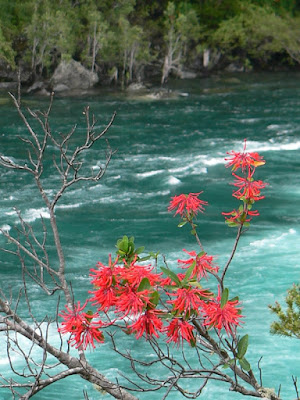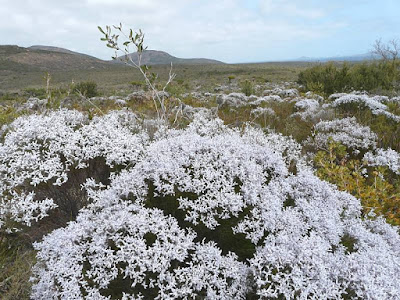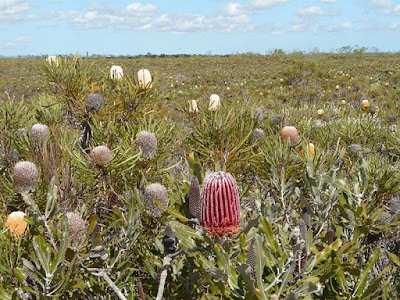I thought it was time to write something more Australian than I've done recently, and it being gloriously spring here at last (and unsurprisingly, with each year spring becomes more precious) flowers seemed an appropriate topic. For no especial reason I thought of the lovely and diverse Grevilleas as a topic, but when I started planning the post I realised that we needed a bit more context, so felt obliged to start with the wider family, the wonderful Proteaceae. (There's probably a name for a brain that obliges me to be so structured, but it doesn't matter because that's the only one I've got, or am likely to have.)
The family is essentially Gondwanan and old one, centred on Australia but represented strongly in southern Africa and to a lesser extent in South America, India, New Caledonia and New Zealand. It has spread north into Africa, into Indonesia and south-east Asia, and into central America and Mexico. There are some 1700 species in about 80 genera; of these 1100 species and 46 genera are Australian.
 |
| Notro or Firebush Embothrium concinnum, Torres del Paine NP, southern Chile. A small but spectacular South American genus whose close relationship with the Australian waratahs (Telopea) is evident. |
The Gondwanan distribution has generally been taken at face value - ie evidence of an ancient group which was present when the southern continents went their own way. Recent molecular dating work (eg DNA sequence research), especially involving Dr Peter Weston of the New South Wales Herbarium, suggests that, counter-intuitively, the various groups dispersed outward from Australia at different times to colonise the rest of their current range by oceanic drift. (A similar result was recently suggested too by research into the ratites - the giant flightless southern birds - suggesting that they must all have flown to their current sites across the southern hemisphere and then all independently lost the power of flight.) All things are of course possible, and I claim no expertise, but both these scenarios seem remarkable to say the least, when compared with the more obvious traditional explanations. I wonder if there is more to be said on this.
Proteaceous plants can be trees, big shrubs, sprawling ground covers and even, in some cases, herbs. In addition to the characteristics noted above under the Grevillea photo, in many species the anthers are attached to the inside of the floral tube. The tip of the style, the stigma, is touching the pollen; as the style grows it puts pressure on the sides of the flower tube until it splits; at this stage the stigma springs out, still bearing the pollen which is taken by either insects or birds depending on the species. Shortly afterwards the stigma grows a brush and becomes a conventional pollen receptor. Flowers may be single, paired or in large spikes.
 |
| Grevillea pectinata near Salmon Gums, southern Western Australia. The upper styles have emerged, the lower ones are still trapped in the flower tube. |
 |
| Banksia speciosa cone near Esperance, southern Western Australia. Only a few of the numerous flowers are usually fertilised. |
| Recently burnt fruit of Mountain Devil Lambertia formosa, near Nowra, New South Wales. The devil's head will soon split to drop the seed into the ash bed. |
 | |
| Hakea microcarpa fruit, Tidbinbilla Nature Reserve near Canberra. Most Hakeas have thick woody cones, but this one has smaller more fragile ones; Grevillea and Lomatia have even more papery fruits. |
 |
| Persoonia sylvatica fruit, Tinderry Nature Reserve south-east of Canberra. |
Another family characteristic (though again not univeral) is the presence of curious root structures called proteoid roots, which grow annually as short very dense masses of root hairs from the sides of normal roots. Their function is similar to that of mycorrhiza (fungal 'hairs' associated with a plant's roots) in other plants, providing a greatly increased root surface area to contact scarce soil nutrients and water. Proteaceae don't have mychorrhiza; the proteoid roots seem to have an association with soil bacteria.
Species are found from very arid central deserts to wet near-coastal forests.
| Hakea lorea, Kata Tjuta NP, central Australia |
| Monga Waratah Telopea mongaensis, Monga NP, south-eastern New South Wales. |
Most plant families have either vertebrate or invertebrate pollinators, but it is probably unsurprising that such a large family should have many strategies; mammals, birds and insects all have roles in different branches of Proteaceae.
| Western Little Wattlebird Anthochaera chrysoptera on Banksia speciosa, Esperance, Western Australia |
 |
| Native bee on Persoonia sp. (Probably Xylocopa sp. - thanks Susan.) |
Five subfamilies are recognised, all being present in Australia.
Symphionematoideae comprises just three species in two genera; Symphionema in New South Wales and Agastyachys in Tasmania
Bellendenoideae has just one species, from the highlands of Tasmania.
| Mountain Rocket Bellendena montana, Ben Lomond NP, Tasmania. The flowers form white spikes in summer; these are the seed capsules. |
Persoonoideae comprises five genera; four are very small and recent work suggests that three of them should properly be included in the best-known genus of the group, Persoonia.
 |
| Persoonia linifolia; the tepals have rolled back to expose the four anthers and central style. |
Proteoideae is a bigger grouping, containing 25 genera including nearly all the African ones.
 |
| Stirlingia latifolia, Badgingarra NR, north of Perth. Commonly known as Blue Boy because cement made from the sand it grows in turns blue! Stirlingia has just seven species, all from Western Australia. |
 |
| Petrophile pedunculata cones, Nowra, New South Wales. These are generally called conesticks from their more elongate woody fruits. There are some 70 species, again mostly in the west. |
Grevilleoideae contains the 'big three' Australian genera, plus most of the Australian rainforest species, the Malesian species, and the American ones.
| Lomatia polymorpha, Mount Field NP, Tasmania. This genus of 12 species is found on the Pacific sides of both Australia and South America. |
 |
| Lomatia hirsuta, Volcano Orsono near Puerto Montt, southern Chile. |
| Orites lancifolia, high Namadgi National Park, above Canberra. In addition to the seven Australian species (most of which are Tasmanian) there are two in South America. |
Well, if you're still reading after all this - thank you! I hope it's been worth it. As noted, there will be postings on two or three of these genera in the future but for now that's enough! If you can go and see some actually growing now, so much the better.
BACK ON TUESDAY






